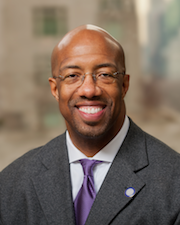Questioning the Calculations |
College Promise Programs | Donate! 


What’s AHEAD Commentary [June 2016]
To join the discussion on these commentaries, please visit our Facebook page:
https://www.facebook.com/PennAHEAD
Closing Gaps in Higher Education Attainment
In our latest What’s AHEAD poll, we focused on differences across groups in higher education attainment. Below, Penn AHEAD’s Laura Perna contextualizes the What’s AHEAD poll results in light of findings from the Pell Institute and Penn AHEAD’s April 2016 Indicators of Higher Education Equity in the United States: 2016 Historical Trend Report. We also invited three Penn GSE alumni, all leading scholar-practitioners, to comment: Dr. Michael Sorrell (Paul Quinn College), Dr. Julie Amon (Rutgers University-Camden), and Dr. Anthony Rini (Northeastern University).
We Must Do More to Close the Gaps
 Laura W. Perna
Laura W. Perna
James S. Riepe Professor and Executive Director, Penn AHEAD
University of Pennsylvania
Despite considerable investment by federal and state governments, philanthropic organizations, colleges and universities, and other organizations, college-related outcomes continue to vary across demographic groups. Indicators of Higher Education Equity in the United States: 2016 Historical Trend Report, released in April 2016 by The Pell Institute for the Study of Opportunity in Higher Education and Penn AHEAD, draws on multiple sources of data to document substantial, persisting differences in college enrollment, choice, and completion based on family income and other demographic characteristics. Among other findings, the report shows (using data from the Educational Longitudinal Study of 2002 High School Sophomores) that only 15% of students from the lowest socioeconomic status quartile attained a bachelor’s degree within eight years of their scheduled high school graduation, compared with 60% of students from the highest socioeconomic status quartile.
This What’s AHEAD poll probes higher education leaders’ views about differences across groups in higher education attainment. Most respondents agree that higher education institutions must do more to close the gaps. More than one in four calls for more attention to improving attainment for students from low-income families.
In our essay in the 2016 Indicators report (pp. 75-80), “Reducing the Stratification of College ‘Choice,’” Roman Ruiz and I discuss the forces that contribute to differences in the types of colleges and universities attended by students from lower- and higher-income families. We highlight the resource constraints and structural failures in our nation’s educational systems that contribute to the concentration of low-income students in less selective and open-access institutions. Like some of the respondents to this What’s AHEAD poll, we also call for a more comprehensive approach that recognizes and addresses the multiple forces that influence college outcomes for students from lower-income families.
The stubborn persistence of gaps in college-related outcomes suggests that current approaches are not enough. Most respondents to this What’s AHEAD poll believe that available resources are insufficient for closing the gaps. But what if more resources are not forthcoming? What might higher education leaders do differently and better, with the resources that are available, to make meaningful improvements in the college-related outcomes of students from low-income families and other underserved groups?
Attainment 101: Life, Learning, and More
 Michael J. Sorrell
Michael J. Sorrell
President
Paul Quinn College
Much of the current debate in K-12 and higher education concerning the educational attainment of students from low-income backgrounds fails to fully appreciate the magnitude and root causes of the problem. The most popular school of thought is that the surest way to address educational attainment is by providing low-income students with an exemplary in-school experience or enrolling them in “blue-chip” colleges and universities. Such logic is fatally flawed and fails to acknowledge the daily realities of students from under-resourced backgrounds. If we want to improve educational attainment, we must first deal with the effects of intergenerational poverty and what it does to those trapped within its grasp because an “A” education coupled with an “F” environment seldom yields an “A” life.
Today’s version of intergenerational poverty is about more than just a lack of wealth. Rather, it is also about what the absence of access to life’s basic necessities can do to one’s hopes and ability to dream. After all, how hopeful can anyone be when daily life allows for no simple thing to be done simply? How many dreams can survive a life without access to healthy and affordable food or adequate transportation, and streets free of stray dogs and debris?
If higher education is sincere about improving the educational attainment of low-income students, then it must do more for the communities that produce these students. This means going beyond the prototypical civic engagement programming (that all too often comes across as poverty tourism) and feel-good public relations events. Rather, higher education must use its considerable collective resources to create environments where entire families are uplifted and can thrive, not just the “exceptional” members. By doing so, not only will the attainment issue be settled, but our society will become a better and more just place.
Achieve Equity and Success One Student at a Time
 Julie L. Amon
Julie L. Amon
Vice Chancellor for Undergraduate Education and Student Success
Rutgers University–Camden
It is not surprising to see that higher education leaders have been impacted by the recent increased national attention on degree completion. Not only are they focused on this issue and believe they should do more, but they also acknowledge the inequity that exists in higher education attainment in this country. Respondents identify low-income students as the group most deserving of additional concern, and most believe that insufficient academic preparation is the largest contributing factor to the attainment gap.
However, the survey question that asks which student groups receive the most focus, and which groups should receive more attention to increase attainment, speaks to the challenges we still face in achieving an equity-based mindset for student success and degree completion. Understanding and recognizing differential degree attainment and the factors that contribute to that is essential, but acknowledgement without a commitment to change our practices will get us nowhere.
If higher education leaders are serious about closing the attainment gap, they must serve the students they have, meet students where they are, and believe that all students are capable and deserving of success. Often when faced with unequal attainment data, leaders assume a “blame the victim” mentality. We bemoan poor academic preparation; we rely on cultural assumptions and biases to explain away student behaviors that don’t lead to success; we lament limited resources; we accept that certain students just won’t make it. Rarely do we look within our own institutions to identify structural, cultural, and pedagogical barriers that limit success for all students. Further, we seldom engage our students in conversations about what barriers they face and how we can help them succeed.
Higher education leaders need to drive the completion agenda through innovation, collaboration, and a relentless focus on student success. This issue should keep us up at night.
Higher Education Leaders Are Key to Economic Recovery
 Anthony L. Rini
Anthony L. Rini
Vice Provost for Budget, Planning and Administration
Northeastern University
We are entering the final innings of the U.S. presidential race. The major parties have presented two unique candidates. While many issues divide these candidates, one is central to who will win this race. The democratic candidate is running on the political and economic record of the past eight years while her opponent, at times, sounds like he is running against the sitting president. The real issue being debated is the economic recovery which has, or has not, occurred since 2008. Are we better off than we were eight years ago? It depends. For those with a college degree, the economic recovery, while slow, has been real. Many others feel left behind.
The importance of post-high school education is well documented in employment and lifetime earning statistics. Yet access and degree completion remain out of reach for many, including low income, first generation, and underrepresented minorities. The challenges facing these populations are numerous, including insufficient preparation for college work, the cost of degree attainment, and personal commitments of family and employment.
While higher education leaders spend a lot of time thinking about these issues, most take little or no action given lack of incentives and the high cost to remove these barriers. Colleges and universities continue to make investments which advance institutional reputation. Admitting an incoming class of high achieving first-time full-time freshman and increasing the diversity of this cohort, and then ensuring that a high percentage of these students graduate, are key factors in winning the prestige race. Investments in scholarships for low-income students, and building the necessary infrastructure to support the success of these students, is costly and has no impact on the prestige race.
Leading higher education institutions in our nation can solve this problem by addressing affordability and creating pathway programs for those seeking a degree. At my own institution, we have a pathway for non-traditional learners into career-focused educational programs. Other institutions have similar pathways, but more institutions could and should make these investments. Small colleges struggling for financial survival could reinvent themselves and deliver innovative career-focused degree programs to non-traditional students. Government funding for programs that address employment shortage areas could help revitalize many struggling institutions and simultaneously jump start local economies.
Back to the presidential race. While we may not all belong to the same political party, the answer to our economic recovery is increasing access to higher education.
To join the discussion on these commentaries, please visit our Facebook page: https://www.facebook.com/PennAHEAD



